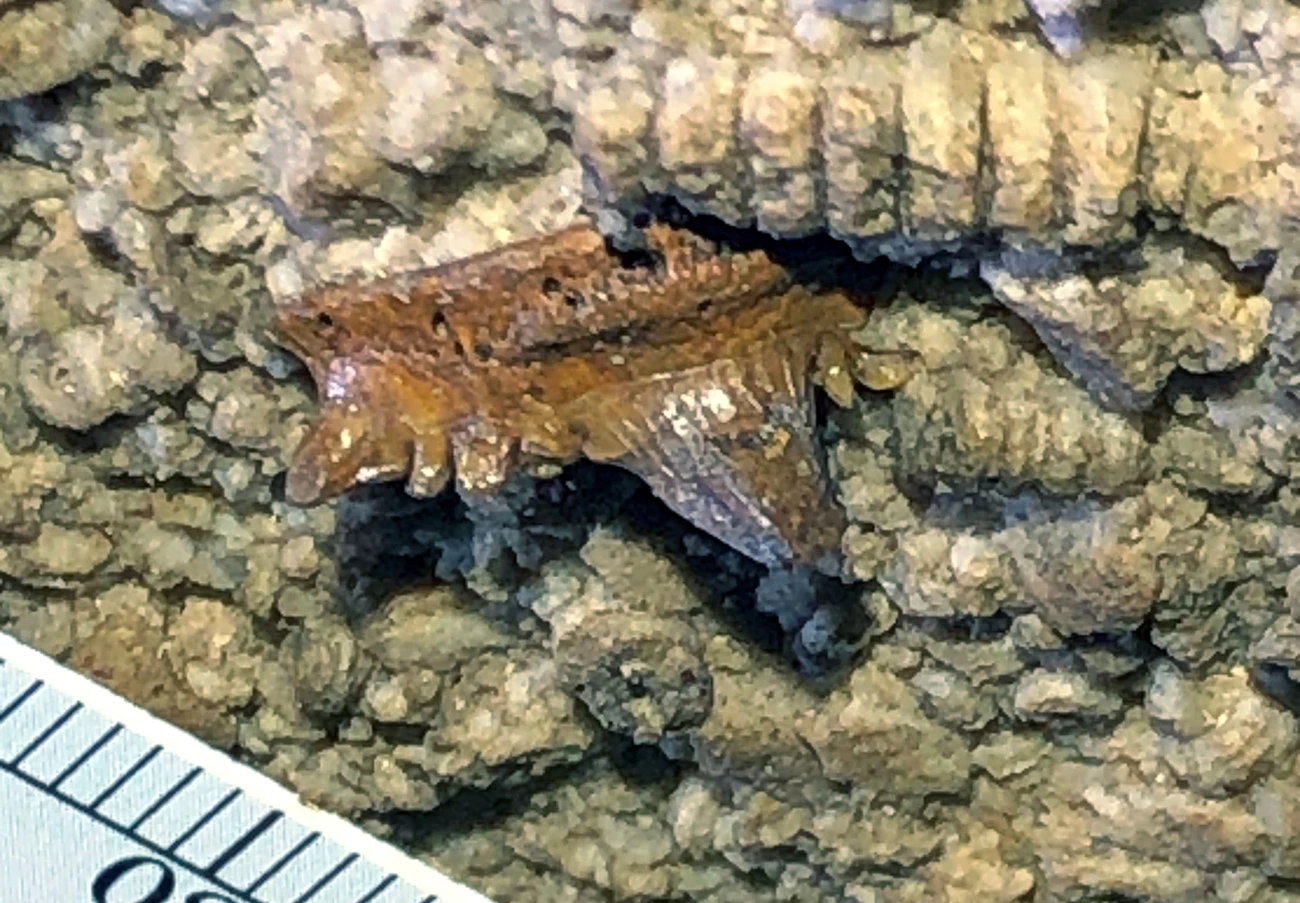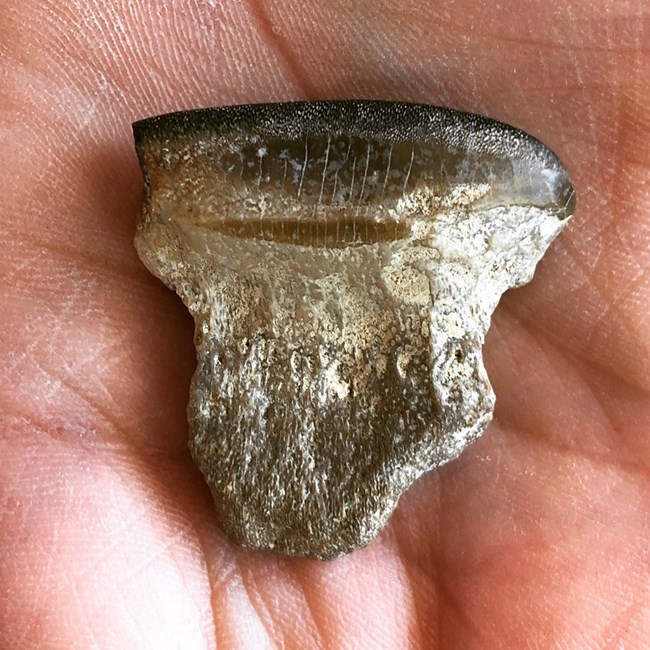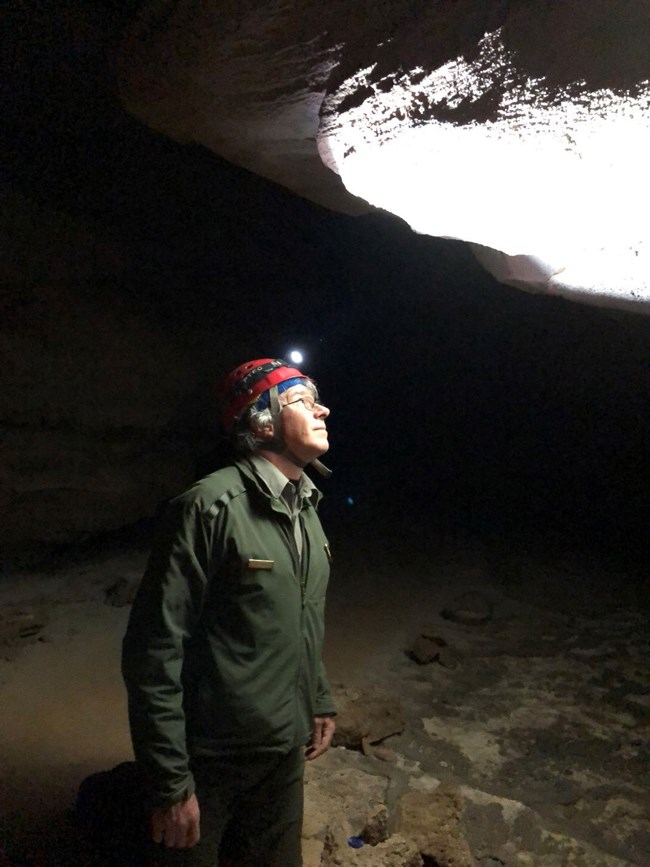Part of a series of articles titled Park Paleontology News - Vol. 12, No. 2, Fall 2020.
Article
The Ghosts of Ancient Sharks at Mammoth Cave National Park

J.P. Hodnett
Paleontologist and National Fossil Day Coordinator

NPS photo by JP Hodnett.
As a vertebrate paleontologist who works on Paleozoic fish, I am amazed at how little is known about the record of these organisms from our public lands. In recent years I have been working with the National Park Service as a both a consultant and researcher, investigating ancient fossils preserved at Grand Canyon National Park (GRCA), Arizona and Mammoth Cave National Park (MACA), Kentucky. Recently, I have been focusing on MACA, where paleontological resource inventories are beginning to reveal a remarkable Late Paleozoic marine vertebrate record. The 2020 MACA Paleontological Resource Inventory is currently working towards producing a document collating the historical published and unpublished records of all fossil resources found at Mammoth Cave, while also exploring and documenting new fossil materials from the park. The 2020 MACA Paleontological Resource Inventory was inspired by discoveries of a number of shark fossils, primarily teeth and dermal spines, found in situ in the cave walls and ceiling.
Mammoth Cave National Park (MACA) is the world’s longest cave system, with more than 400 miles of passageways cutting down through multiple layers of Carboniferous aged rocks. Most of these rocks date to the Late Mississippian subperiod, approximately 340 to 325 million years ago, representing the Visèan and the Serpukhovian ages (using the global geologic nomenclature). At this time MACA and western Kentucky were covered by a shallow sea representing the southern opening of the ancient marine Illinois Basin, which was positioned approximately south of the paleo-equator. The cave passages and tunnels within MACA cut into four geologic formations, from oldest to youngest: the St. Louis Formation, the Ste. Genevieve Formation, the Girkin Formation, and the Big Clifty Formation. These cave passages, formed by the flow and draining of underground freshwater channels some 14 million years ago, allow for a unique view of these sediments and the fossils therein. Many of these fossils have not been subject to typical surface erosion conditions that paleontologists encounter aboveground that can wreak havoc on fossil preservation. Instead, these subterranean fossils appear to be nearly pristine, as if they were exposed just hours before. However, it may have taken ten to hundreds of years of slow water seepage to uncover these fossils.
Most of what has been published on the vertebrate fossils from MACA describes Pleistocene and Holocene animals such as vampire bats, rodents, tapir, saber-toothed cat, and fragments of a mastodon. The earliest account of a Paleozoic vertebrate fossil comes from 1930s correspondence between the MACA General Manager W.W. Thompson and professor J Harlen Bretz of the Geology Department of the University of Chicago, in which Bretz provided Thompson information on a shark fossil (a dorsal fin spine) found within the cave. Bretz identified the specimen to belonging to “Ctenacanthus” and apparently returned the specimen with the letter. Unfortunately, at this time we have not been able to locate the specimen discussed in the letter. Staff at MACA have long known the presence of shark teeth and spines within the passageway walls and ceilings, but no collection and research has been conducted since the 1930s.
That all changed in November of 2019.
MACA resource management specialist and paleontologist Rickard Toomey and park ecologist Rick Olson had noted a number of fossil shark teeth and spines coming from multiple cave tunnels and had corresponded with National Park Service Senior Paleontologist Vincent Santucci, asking if identifications could be made from a series of photos of specimens in situ. Knowing my work on Paleozoic chondrichthyans, Santucci asked me if I could identify the shark fossils. Many of the teeth and spines were identifiable to at least genus, but one photo stood out among all the others. This photo showed a number of large shark teeth amongst what was obviously three dimensionally preserved cartilage! Shark cartilage rarely fossilizes as it is a softer skeletal tissue than bone. The photos provided by Toomey and Olson showed a number of cartilaginous skeletal elements with teeth of a shark called Saivodus striatus. Saivodus striatus is a shark previously only known from teeth alone and is indicative of the Late Mississippian, particular the Visèan stage. Specimens from North America and Europe, based on teeth, reached on average modern great white sizes (12–17 feet in length) or greater.
I was invited by MACA staff to spend a week at the park to see the Saivodus specimen and look at other shark fossils in other passageways in November 2019. The park staff were curious if this specimen represented a skeleton. The trip to see the Saivodus specimen consists of an underground quarter mile trek in which 2/3rds of the journey is on either hands and knees or walking stooped over and traversing around a deep sink hole. Once there I was able to determine that the cartilage is indeed part of the skeleton, representing parts of a very large head! The most distinguishing cartilage exposed were the back end and front end of the lower jaw, which were approximately 2 ½ feet in length (Figure 1). This size for the lower jaw indicated an individual roughly the size of a large modern great white. This is the first skeletal material for the genus Saivodus.
After taking notes and preliminary measurements, we also collected sediments from just under the Saivodus specimen in hopes to collect micro-vertebrate remains through screen washing. We explored the rest of the passage and mapped and collected 40+ teeth and spines of other shark species. The following days we looked at another passageway and found another 70+ specimens of various sharks, including some isolated teeth of Saivodus. All these fossils were collected from the Ste. Genevieve Formation, which until the discovery of the MACA specimens had no record of fossil vertebrate material.

NPS photo by JP Hodnett.
Our work was just getting started, but the excitement of identifying the Saivodus cranial cartilage from MACA could not be contained long. Earlier this year, the University of Kentucky Geology Department was highlighting Matt Cecil (Figure 2), a former undergrad student who was part of the field team to look at the Saivodus specimen, through social media about his involvement in the initial documentation project. News of this large shark discovered in Mammoth Cave spread across the world rapidly, including being featured in CNN, USAToday, and Forbes.
After the media blitz had ended, we set to work on identifying the diverse taxa we had collected in November. To date, at least 37 different species of sharks and 8 other species of fish have been identified (Figure 3).

NPS photo by JP Hodnett.

NPS photo by Hodnett.
The most common shark tooth taxon we have encountered in the Ste. Genevieve Formation is a distant relative to modern ratfish or chimeras called Chomatodus. This extinct shark had sharp bar-like teeth for crimping and crushing shelled organisms. Plate-like teeth from true extinct relatives of ratfish are also rather common within the Ste. Genevieve Formation, and represent about seven different species. We also have a number of new species, including teeth to a new species of Janassa, a skate-like shark known from near complete specimens from the Permian of Germany and the United Kingdom, as well as a possible new species of Petalodus (Figure 4), a large distant relative to extant ratfish.

NPS photo by JP Hodnett.
Screen-washing of the sediments collected beneath the Saivodus resulted in a large sample of micro-vertebrate material. The most common micro-vertebrate specimens we collected were dermal denticles (tooth-like scales) of the ctenacanth shark Saivodus. A number of teeth belonging to small sharks were also collected. The eel-like Thrinacodus (Figure 5) and the marine xenacanth Bransonella were the most common micro shark teeth found. The large number of teeth makes me suspect that these sharks were probably feeding off the Saivodus carcass. Teeth of stethacanthids, sharks bearing elaborate dorsal spines, smaller ctenacanth species, and tiny petalodont chondrichthyans (another distant extinct relative to ratfish) were also collected.
The teeth and spines of sharks have been also been identified from the lower St. Louis Formation and the above Girkin Formation. The number of fossils found within a nearly continuous sequence of sediment and the type of preservation at MACA make this one of the most important Late Mississippian marine vertebrate fossil sites in North America, if not the world. Aside from the work we did in November 2019, MACA staff and volunteers continue to make new discoveries of shark fossils within the Ste. Genevieve Formation.

NPS photo by JP Hodnett
Just before July 4, 2020, Rick Toomey (Figure 6) was going over old cave field work records for any information on possible sightings of fossils and struck paydirt. From a mapping project log back in the early 1990s, it was noted that a crew member had spotted a “small fish jaw” within the ceiling of the passageway they were mapping. The report had the approximate locality information of this fossil, so Rick and his volunteer assistant Vanessa Padilla went to see if they could relocate it. They were successful and the fossil was more than just a mere “small fish jaw”! What the mapping team came across in the 1990s was actually a mostly articulated set of jaws, associated cartilages, and teeth to a smaller ctenacanth species called Glikmanius (Figure 7). Whereas Saivodus is estimated to be as big or bigger than a modern Great White, this particular Glikmanius was about the size of a black tip reef shark (4-5 feet in length) or smaller. What is also exciting, not only does this new cranial material come from the Ste. Genevieve Formation, but like the Saivodus specimen, it is the first cranial material for the genus Glikmanius in the world! On top of that, this is the oldest Glikmanius specimen found to date, which previously was widely known from isolated teeth at Pennsylvanian to Permian localities, including recent new discoveries at Grand Canyon National Park.

NPS photo by Rick Toomey.
The Mammoth Cave National Park Paleontological Resource Inventory continues with further discovery of fossil material anticipated. A preliminary account of the shark assemblage of the Ste. Genevieve at Mammoth Cave will be presented at the 2020 Society of Vertebrate Paleontology annual meeting in October 2020. We are also implementing photogrammetry techniques to document some of the fossils we have been encountering at MACA. These 3D images will help us record the position of these fossils from within the cave and also make it possible to print out 3D models as voucher specimens for the museum collection for specimens that would be deemed too difficult or risky to remove.
To illustrate the significance and diversity of the Ste. Genevieve fossil assemblage, paleo-artist Julius Csotonyi was commissioned to reconstruct a 240-million-year scene showing the diversity of vertebrates and invertebrates that once occurred at the park during the Late Mississippian subperiod (Figure 8).

Painting by Julius Csotonyi. NPS image.
Julius Csotonyi is a world-renowned paleo artist who has done work for multiple institutions and educational venues such as the Smithsonian National Museum of Natural History’s new Hall of Deep Time. He depicts the remains of a Saivodus carcass on the sea floor, being fed upon by various other smaller vertebrates, amongst the crinoid forest that is preserved at MACA. Larger sharks are on the periphery of the carcass with a giant mature Saivodus looming in the background. Julius drew from his extensive experience of illustrating extinct and extant sharks from previous projects along with notes from myself and MACA staff to bring this scene to life. This image will be a primary educational source for visitors to Mammoth Cave on the rich fossil history preserved there and highlights a significant fossil resource within the National Park Service.
Much of our current field success at MACA comes from both the leadership of Rick Olson and Rick Toomey and from the vigilant work of their support staff and volunteers who have been keeping a sharp eye out for new shark fossil occurrences in passages while working on other cave projects. Their work is showing that Mammoth Cave National Park has one of the richest Paleozoic marine vertebrate records in the world and should be considered a world-class fossil site. As we continue our field and lab work, who knows what we might find around the next corner!
Related Links
- Mammoth Cave National Park, Kentucky—[Geodiversity Atlas] [Park Home]
- NPS—Fossils and Paleontology
- NPS—Geology
Last updated: April 20, 2021
